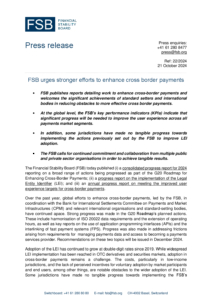The Legal Entity Identifier (LEI) was established in 2012 as a way to uniquely identify counterparties to financial transactions across borders, and thereby to improve and standardise financial data for a variety of purposes. In 2022, the FSB explored how the LEI could help achieve the goals of the G20 Roadmap for faster, cheaper, more inclusive and more transparent cross-border payments. Both authorities and market participants have recognised the potential benefits of the LEI in strengthening data standardisation as well as assisting know-your-customer (KYC) processes, and sanctions screening, including the Bank for International Settlements Committee on Payments and Market Infrastructures, and the Financial Action Task Force.
Globally, the number of active LEIs has reached 2.6 million, increasing by 84% compared to 2019. The LEI is widely used in particular in OTC derivatives and securities markets, but its benefits have been recognised for a broad range of use cases in the financial sector.
Nevertheless, broader adoption of the LEI in cross-border payments remains challenging. The costs, particularly in low-income jurisdictions, and the lack of perceived incentives for voluntary adoption by market participants and end users, among other things, are notable obstacles to the wider adoption of the LEI. Some jurisdictions have made no tangible progress towards implementing the FSB’s previously outlined actions. To maintain the momentum in expanding LEI adoption, particularly for cross-border payments, the FSB reiterates its 2022 recommendations and advocates for their full and timely implementation. The report includes additional recommendations for oversight authorities and standard-setting bodies to support this.
Recommendations
- FSB member jurisdictions, in collaboration with the ROC and the GLEIF:
- Continue exploring ways to promote LEI adoption, particularly outside the financial sector, including ways to promote awareness and adoption of the verifiable LEI to enhance trust in digital exchanges through verifiable authentication.
- Explore, where appropriate, the scope to mandate use of the LEI for certain payment message types for routing message formats migrating to ISO 20022 messages.
- Continue exploring, with national regulators and others, the role the LEI might play in assisting entities with due diligence for KYC, as well as other use cases such as sanctions screening.
- Consider a staged approach to the introduction of the LEI requirement in payment messages, by assessing which categories of entities or which thresholds of payment value could be considered for the gradual introduction of LEI requirements for payments.
- Relevant standard-setting bodies and international organisations should consider issuing guidance on the role that the LEI and possibly the vLEI might play in assisting entities with due diligence for KYC and sanctions screening, and fraud prevention.
